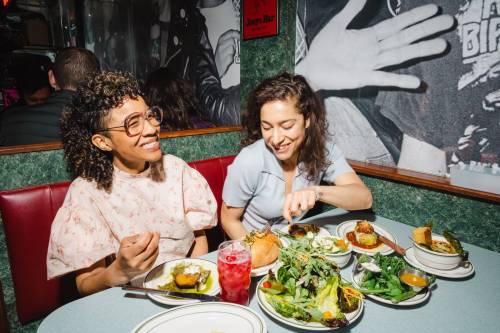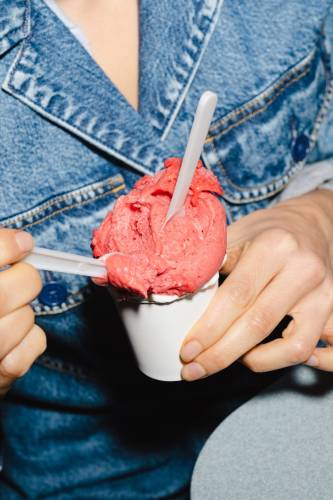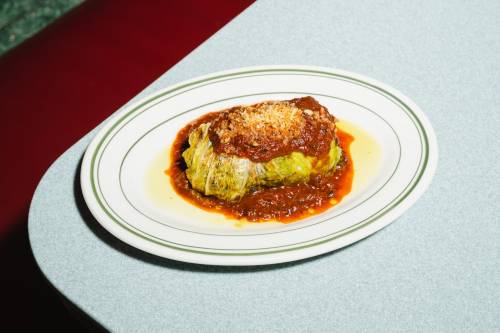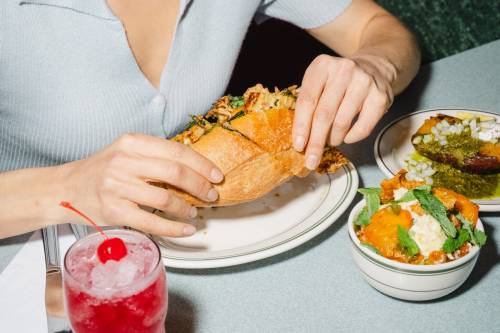At 9 P.M. one recent Saturday at Superiority Burger, the chef Brooks Headley was ricocheting around the dining room. A profile in GQ revealed that he clocked about thirty-five thousand steps, or roughly seventeen miles, each night. And who could blame him? For six years, he spent the majority of his time in the three hundred square feet of the restaurant’s original location. Earlier this year, he relocated to the relatively sprawling space that, for decades, had housed the Odessa Restaurant, a beloved East Village greasy spoon.
The original Superiority Burger offered just six dishes, plus specials and desserts. (Headley began his kitchen career as a fine-dining pastry chef.) All of it, including the eponymous burger, was vegetarian; a lot was “accidentally vegan.” Everything popped. The move, theoretically, might have overwhelmed Headley with possibilities, but on recent visits I was delighted to find that he is keeping the focus as tight as ever.

All of the food, including the eponymous burger, is vegetarian; a lot is “accidentally vegan.”
There are cocktails now, expertly made but nothing you’d use the word “craft” to describe. On my first visit, as I waited at the bar for a table, I enjoyed a Cape Cod, with real cranberry juice and supremely carbonated seltzer from a high-end Japanese dispenser, and used all my quarters on a gumball machine filled with the world’s best snack mix, a buttery mélange of broken Ritz crackers, peanuts, and Crispix, scented with cumin. The mixed drinks are seventeen dollars, which seems both standard these days and also jaw-dropping, especially for Alphabet City’s slightly grizzled, sellout-resistant remaining punks, of which Headley is one. (He was the drummer for several hardcore bands.) “YIKES!” the menu notes, next to the price, defensively.

A gumball machine by the bar contains the world’s best snack mix, scented with cumin.

Gelato and sorbet flavors, such as rhubarb, rotate weekly.
But, compared with other restaurants of this calibre, the food prices feel shockingly low, especially given the obvious quality of the produce, some of it sourced from Campo Rosso, a specialty vegetable farm in Pennsylvania. The burger, made from quinoa, chickpeas, and walnuts, is thirteen dollars. The most expensive dish, at nineteen dollars, is the Yuba-Verde, a spectacular sandwich featuring chewy, slightly stretchy folds of yuba, or soy-milk skin, griddled and layered with chickpeas, broccoli rabe, and mayo on a crusty Italian hero. More menu marginalia: “incl freight the cost per gram of premium yuba is equivalent to that of American Wagyu.”
Holdovers from the old menu include the Sloppy Dave (tofu chili, frizzled onions), the burnt-broccoli salad (eggplant purée, candied cashews), and the beets with cream cheese and pretzels, all still wonderful. New additions are few but powerful. In a nod to Odessa’s Ukrainian heritage, there’s a texturally thrilling stuffed cabbage, filled with sticky rice and oyster and button mushrooms, draped in a sweet-and-sour tomato sauce, and finished with crunchy focaccia bread crumbs. A plate of steamed vegetables, one night, was as deceptively simple as a Rothko—perfectly al-dente spears of asparagus, overwintered carrot, and broccolini to be dipped in a luscious lemon-tahini dressing and a tart, fruity hot sauce.

The stuffed cabbage is a nod to the Ukrainian heritage of the Odessa Restaurant, which occupied the space for decades.
The market salad, a tower of leaves—Little Gem, arugula, frisée—strewn with shredded carrot, fennel, herbs, bread crumbs, and pickled bird’s-beak chilies, was trumped only by a special: apricot panzanella, featuring silky halves of the griddled fruit, focaccia croutons, torn hunks of mozzarella, wedges of cucumber, and Thai basil.
The panzanella was dessert-adjacent, in part because many of the desserts, under the purview of the pastry chefs Darcy Spence and Katie Toles, walk the line between sweet and savory: earthy, herbal coriander-banana gelato; a salty malted date shake. The first time I tried the Pearl Pie, a triangle of passion-fruit custard on a Ritz-cracker base, it was shellacked in passion-fruit glaze and topped with passion-fruit seeds and iridescent tapioca pearls. The second time it was also dusted with crimson-hued li hing mui, a preserved-plum powder that’s popular in Hawaii, where Toles grew up. It was bright, sour, a little defiant, just right. (Dishes $9-$19.) ♦

The most expensive dish on the menu is the Yuba-Verde sandwich, which features soy-milk skin that costs almost as much to procure as American Wagyu beef.
Sourse: newyorker.com






